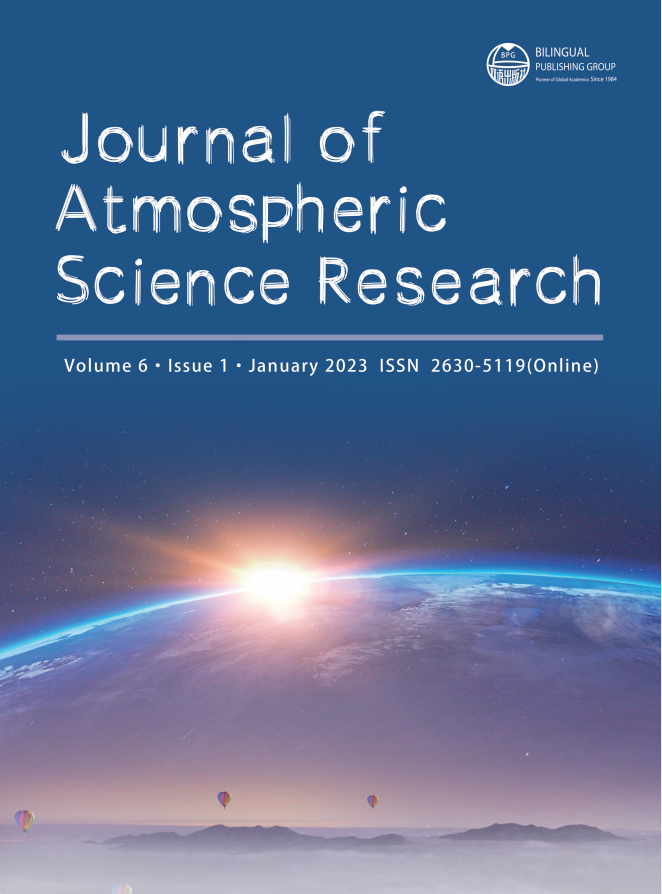-
861
-
411
-
362
-
359
-
350
Ionospheric Currents in the Equatorial and Low Latitudes of Africa
DOI:
https://doi.org/10.30564/jasr.v6i1.5092Abstract
The magnetometer data obtained for 2008 from geomagnetic stations installed across Africa by magnetic data acquisition set (MAGDAS) have been used to study the ionospheric Sq current system in the equatorial and lowlatitudes of Africa. The aim of this work is to separate the quiet-day feld variations obtained in the equatorial and low latitude regions of Africa into their external and internal feld contributions and then to use the paired external and internal coeffcients of the SHAto determine the source current and induced currents. The method used involved a spherical harmonic analysis (SHA). This was applied in the separation of the internal and external field/current contribution to the Sq variations. The result shows that the variation in the currents is seen to be a dawn-to-dusk phenomenon with the variation in the external currents different from that of the internal currents both in amplitude and in phase. Furthermore, the seasonal variation in the external current maximizes during the March equinox and minimizes during the December solstice. The maximum current observed in AAB and ILR is due to the Equatorial Electrojet Current present in the AAB and ILR stations. Seasonal variation was observed in the geomagnetic component variations as well as in the currents. This is attributed to the position of the sun with respect to the earth at different months of the year. The equinoctial maximum is observed in external current intensity which occurred mostly during the March Equinox.Keywords:
Equatorial; Low latitudes; Africa; Ionospheric Sq; CurrentsReferences
[1] Chapman, S., Bartels, J., 1940. Geomagnetism. Oxford University Press: London.
[2] Obiekezie, T.N., Okeke, F.N., 2010. Upper mantle conductivity determined from the solar quiet day ionospheric currents in the dip equatorial latitudes of West Africa. Moldavian Journal of the Physical Sciences. 9(2), 199-204.
[3] Campbell, W.H., Schiffmacher, E.R., 1988. Upper mantle electrical conductivity for seven subcontinental regions of the earth. Journal of Geomagnetism and Geoelectricity. 40(11), 1387- 1406. DOI: https://doi.org/10.5636/jgg.40.1387
[4] Takeda, M., 1999. Time variation of global geomagnetic sq field in 1964 and 1980. Journal of Atmospheric and Solar-Terrestrial Physics. 61(10), 765-774.
[5] Takeda, M., 2002. The correlation between the variation in ionospheric conductivity and that of the geomagnetic Sq field. Journal of Atmospheric and Solar-Terrestrial Physics. 64(15), 1617-1621. DOI: https://doi.org/10.1016/S1364-6826(02)00140-2
[6] Gauss, C.F., 1838. Allgemeine Theories des Erdmagnetismus, in Resultate aus den Beobachtungen des magnetischem Vereins in Yahr (in German) [General theories of terrestrial magnetism, in results from the observations of the magnetic society in Yahr]. Sci. Mem. Select. Trans. For. Acad. Learned Society Foreign Journal. 2, 184-251.
[7] Campbell, W.H., 1997. Introduction to geomagnetic fields. Cambridge University Press: New York.
[8] Campbell, W.H., 2003. Introduction to geomagnetic fields. New York: Cambridge University Press.
[9] Moldwin, M., 2008. An introduction to Space Weather. New York: Cambridge University Press. 122.
[10] Obiekezie, T.N., 2012. Geomagnetic field variations in the dip equatorial latitudes of West Africa. International Journal of Physical Sciences. 7(36), 5372-5377.
[11] Campbell, W.H., 1979. Occurrence of AE and Dst geomagnetic index levels and the selection of the quietest days in the year. Journal of Geophysical Research. 84, 875.
[12] Okeke, F.N., Rabiu, A.B., 1998. Some aspects of the earth’s mid-latitude geomagnetic field variations. Irish Astronomical Journal. 26(1), 29-32.
[13] Rabiu, A.B., 2002. Seasonal Variability of Sq at Middle latitudes [PhD thesis]. Nsukka, Nigeria: University of Nigeria.
[14] Obiekezie, T.N., Obiadazie, S.C., Agbo, G.A., 2013. Day-to-Day Variability of H and Z Components of the Geomagnetic Field at the African longitudes. ISRN Geophysics. 7.
[15] Rastogi, R.G., 2002. A new look at the ionospheric current system. Indian Journal and Radio and Space Physics. 31, 67-74.
[16] Campbell, W.H., Arora, E.R., Schiffmacher, E.R., 1993. External Sq currents in the Indian— Siberia region. Journal of Geophysical Research: Space Physics. 98, 3741-3752.
Downloads
How to Cite
Issue
Article Type
License
Copyright © 2023 Authors

This is an open access article under the Creative Commons Attribution-NonCommercial 4.0 International (CC BY-NC 4.0) License.




 G. C Emenike
G. C Emenike






